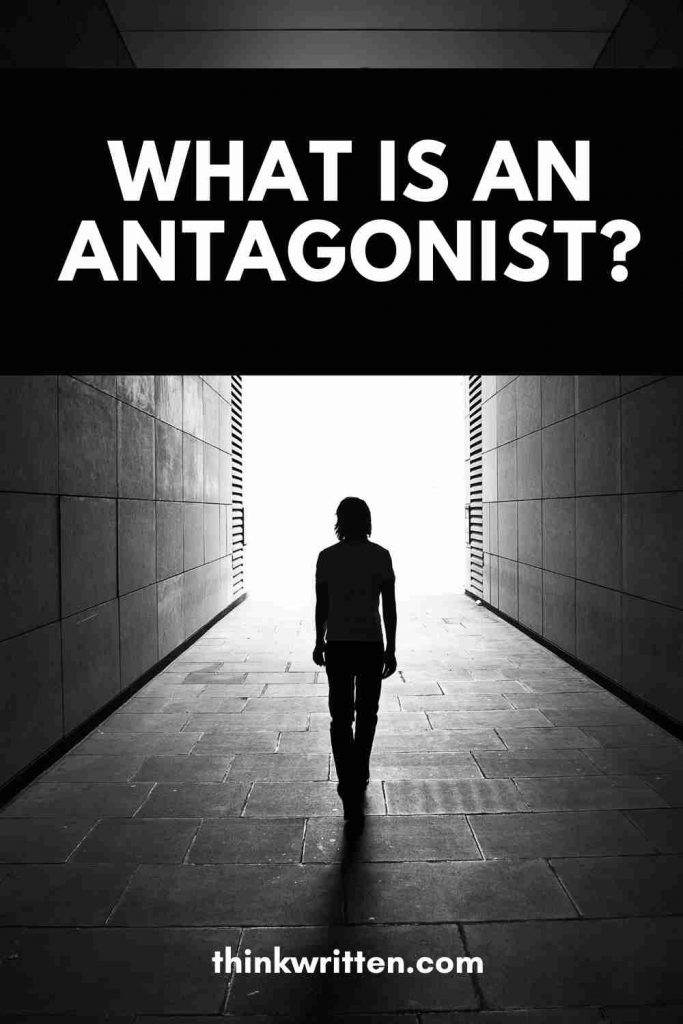We may receive a commission when you make a purchase from one of our links for products and services we recommend. As an Amazon Associate we earn from qualifying purchases. Thank you for support!
Today we’re going to talk all about what an antagonist is in literary fiction and explain why it’s important to have one to create conflict in your story.
Newton’s third law of physics states that for every action, there is an equal and opposite reaction – for every force, a force to counteract it. This is as true in the art of writing fiction as it is in the exercise of the physical sciences.
We’ve talked at length about protagonists and deuteragonists, two forces moving in complimentary, if not exactly identical directions. Now, we come to the antagonist.

Antagonists Create Conflict in a Story
An antagonist is defined as someone or something who opposes the protagonist. Antagonists challenge the protagonist and create conflict in the story.
In order to write a convincing story, it’s always important that you have conflict which is resolved. An antagonist is a character who can help you add tension and conflict to your story.
If the protagonist is there to advance their own causes, then the antagonist is that force counteracting them, be it a person, place, or thing.
More often than not, the antagonist is sometimes viewed as the “Bad Guy” in a story. But before it gets confusing, let me make one thing clear – the antagonist is not always a villain. Villains are a class of antagonists, but not the whole category. I’ll address this more in an upcoming article on How to Write a Good Villain.
While protagonists provide readers with the main source of forward momentum in a story, the antagonist is equally important in providing a source of conflict.
A story that cruises through from beginning to end without an obstacle isn’t a very believable tale – and not a very enjoyable one to read.
Every good story needs at least one good antagonist, or possibly more, and the considerations when creating one (or several) are fundamentally the same as when you create your protagonist.
The antagonist needs to have a real reason to be in conflict with the protagonist. Maybe they were rivals in school or former business partners who fought over money.

Understand that while the source of conflict is important, it doesn’t have to be so severe that the protagonist and antagonist are full-on enemies.
There should be palpable tension between them and the reason for the conflict should be made apparent at some point in the story.
How much time the antagonist gets on stage depends on how important they are to the protagonist.
The main antagonist should be given almost as much time as the protagonist. The main antagonist is the primary source of conflict, so their relationship with their counterpart needs to be explored thoroughly. Smaller obstacles get less time on stage.
How many antagonists you need to plan for depends entirely on you, your story, and the kinds of antagonists you want to use.
A short story should ideally have only one active antagonist. There simply isn’t enough space for you to tell too many tales. My recommendation is that this rule stay true all the way up to a novella (fewer than 50,000 words, but more than 20,000). Novels (and serial novels) lend themselves better to having multiple active antagonists.
Types of Antagonists and Examples
There are two essential types of antagonists. One is active – they seek to disrupt the path of the protagonist. The other is passive – they obstruct the path of the protagonist, but only because they exist within their path already.
As a writer, you can use one or the other or even both. Depending on the story you’re discovering, you may have room to feature more than one. Just don’t forget the main rule to writing fiction – everything must serve the story, else it doesn’t belong in the story.
What follows here are some examples of antagonists in their various forms:
Antagonist as Person (Active)
As a person, the antagonist could be any of a number of persons or groups of people that stand in opposition to the antagonist. Sometimes the person is evil – your standard Emperor Palpatine, seeking the destruction of the light in furtherance of his evil designs.
Sometimes, and often more believably in dramatic or literary fiction, the antagonist is someone who simply sees the world differently from the protagonist.
A great example of this comes from the film Field of Dreams (based on the book Shoeless Joe), wherein Kevin Costner plays Ray Kinsella, a farmer who, after being called by a formless apparition and seeing the ghosts of baseball players long passed, decides to till under his field of corn and put in a baseball field.
His brother-in-law, Mark, is the antagonist of the film, but he is not looking to fulfill some evil destiny. He wants to buy and modernize the farm that Ray wants to all but destroy to follow this other dream.
Antagonist as Thing (Active or Passive)
No, not The Thing of comic book fame. Non-sentient (and sometimes sentient, depending on your genre of writing) objects or naturally – or unnaturally occurring phenomena can be antagonists, as well.
There are a few great examples that come to mind immediately. First is Stephen King’s Christine, in which the antagonist of the story is a possessed 1958 Pontiac Fury that goes on a murderous rampage.
Sebastian Junger’s The Perfect Storm (based on true events) presents us with a story where the protagonist – the captain of the Andrea Gail – is pitted against a storm after carelessly ignoring warnings to turn for safe harbor.
In George Orwell’s 1984, the antagonist can really be considered the whole of society. In the end, the Thought Police of Orwell’s Oceania are embedded in all levels of society, from neighbors to coworkers to the people the protagonist, Winston, believes to actually be helping him. In a sense, everyone in 1984 except the two main protagonists is an antagonist.
Antagonist as Place (Passive)
Sometimes, it seems like the whole world is out to get you. Sometimes, that is a literal truth. Oftentimes, the terrain itself serves as an antagonist. And with some skilled anthropomorphization, this can add several layers of flavor to your story.
In Lawrence of Arabia, the Nefud Desert is set as one of the antagonists against the titular character. Deserts appear to serve as antagonists in several stories, such as the story of Exodus in the Bible, or The Gunslinger by Stephen King.
Places that challenge the survival of humans often serve as antagonists. In the German film, North Face, about mountaineers attempting a climb of the northern face of Eiger, the most dangerous climb in the Alps, the mountain itself is an antagonist for the German and Austrian climbing teams around which the story centers.
Do you have any questions about what an antagonist is? Share your thoughts in the comments section below!






